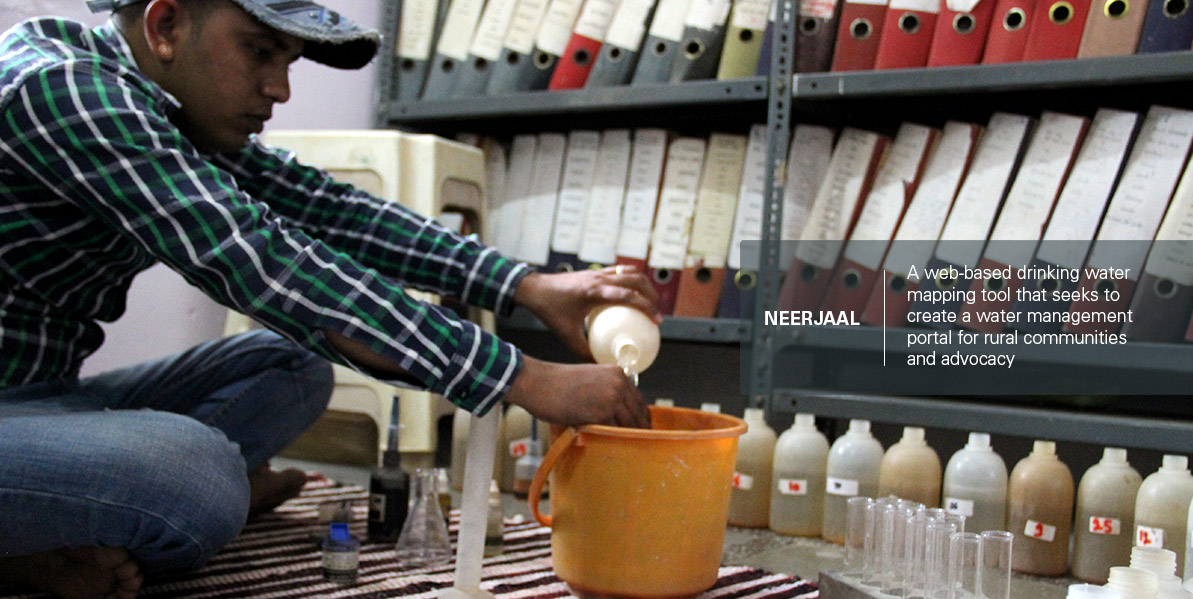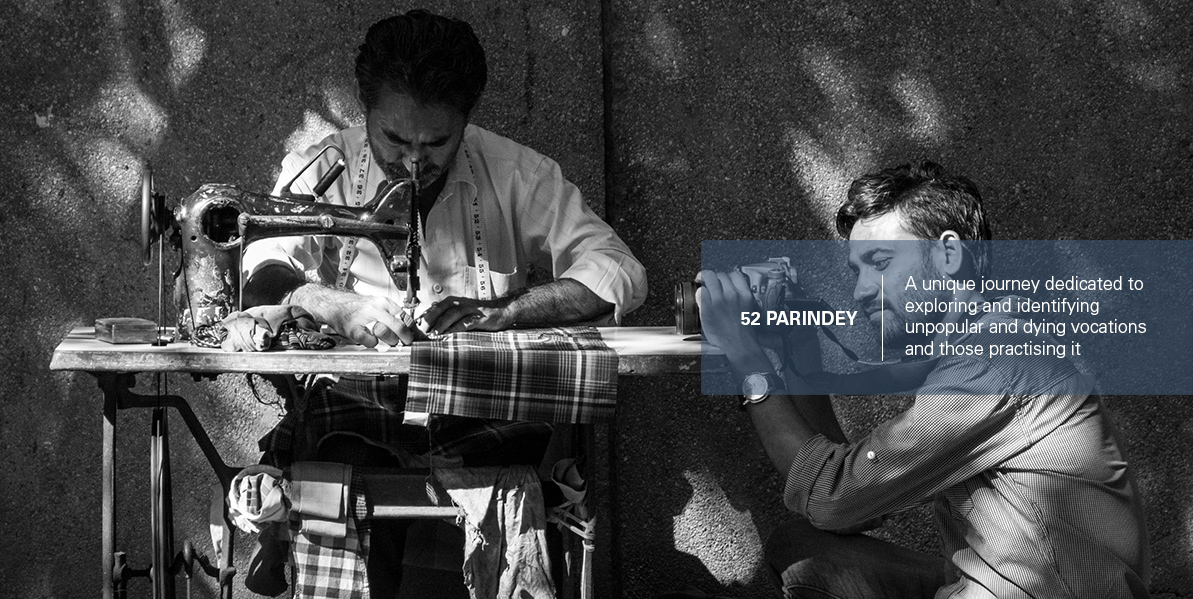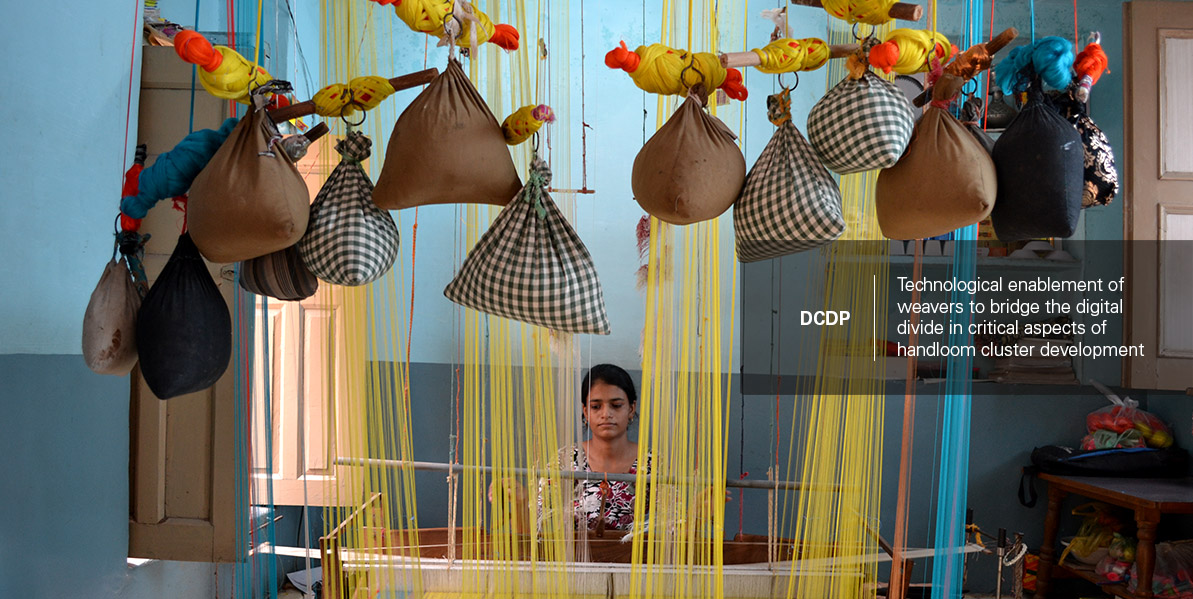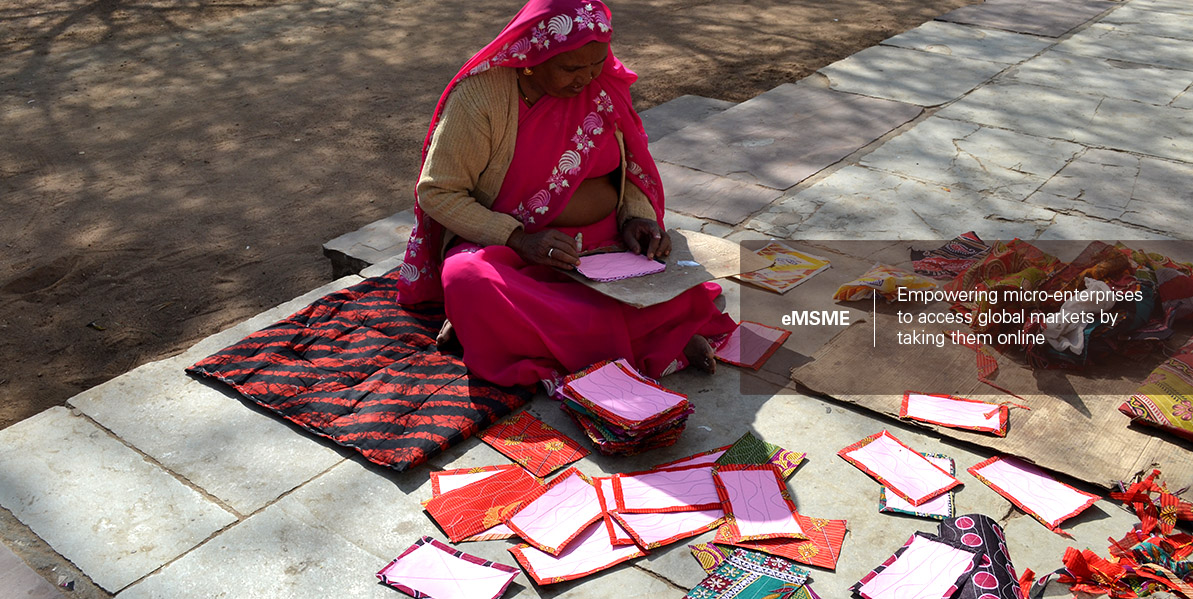Markets & Enterprise
One major mandate flowing from DEF’s Mission and Vision statements is ensuring greater integration of grassroots markets with the global market through digital intervention. Projects in this programmatic area seek to enable and empower grassroots businesses to access global markets and vice versa. They also seek to promote and strengthen entrepreneurship within marginalised and digitally_excluded communities through digital interventions and, thereby, serve the cross-cutting goal of society-wide digital inclusion.
Through three projects, 1,350 micro entrepreneurs have been digitally empowered, more than 3,500 handloom weavers of Chanderi (Madhya Pradesh) now use digital tools and have an e-commerce portal, and more than 50 women entrepreneurs have been digitally trained.
Projects
E-MSMEChanderiyaanWireless Women for Entrepreneurship and Empowerment
Empowering micro-enterprises, especially in rural and semi-urban areas, by helping them set up their own websites and go online to access global markets for both inputs and finished products and services.
As part of the e-MSME project, entrepreneurs running small and micro enterprises are provided one tp three day – customised residential ICT training about how digital tools can help them in their business and skills. It also enables micro, small and medium enterprises to have their own website and manage them on their own.
Through the e-MSME initiative, Digital Empowerment Foundation aims to provide MSMEs a webspace – in local languages and/or English – to increase their visibility and empower them with useful tools that can facilitate and enhance their business development in:
- Communication & outreach
- Leading generation & attracting clients
- Parnterships & direct linking with other agencies
- Human resource support to avail skilled human resources
- Giving voice to local entrepreneurs
Focus Area
Residential ICT training about how digital tools can help in business and skills.
Impact
- 1,350 entrepreneurs digitally empowered by enabling them to have their own websites and online presence
- 135 clusters spread across five districts in three states now online
- All digitally empowered entreprenuers now have a global presence to showcase local products and services
Team member
Devendra Singh Bhadauria
9044904904
devendra@defindia.net Website emsme.in
Recent Updates
Posts not found
Contact Details
Devendra Singh Bhadauria
Programme Manager
9044904904
E-Mail: devendra@defindia.net
Demonstrating the power of digital intervention to improve the financial status of traditional artisans of Chanderi who produce the world famous and expensive Chanderi sarees, thus creating a model for traditional-skill based clusters.
Chanderi is a small municipality in Ashoknagar district of Madhya Pradesh and is home to some 3,500-odd weaver families who are known the world over for producing Chanderi sarees and apparels that generate a revenue of about Rs 1.5 billion every year. But the weaver families who produce these marvellous handloom products, based on designs and techniques dating back to the 13th century, used to earn on less than Rs 2000 per month on an average until DEF launched its Chanderiyaan project in 2010.
Till 2010, there was rampant exploitation by middle men, a 40 per cent illiteracy rate, a 100 per cent digital illiteracy rate, none of the 13 schools in the area had a computer lab, the area had almost no health facilities and, most importantly, the craft itself was on the verge of becoming extinct as few children of weavers were willing to learn the craft and continue with the same profession.
But the Chanderiyaan project has changed all that. Today, average household incomes have more than tripled due to various consequences of ICT intervention. Almost all weaver families have at least one digitally literate person in the household; weavers, especially the younger generation, are now using Computer Aided Design software to develop new, more accurate designs based on modern aesthetics to appeal to the sensibilities of the upmarket global and domestic customers and a variety of ICT-enabled training programmes have helped people in the community learn new vocational skills relevant to the learner’s environment as well as English language skills. Tourism has been promoted as another revenue earning stream by fully documenting digitally the many historical monuments in the area apart from documenting stories about the art and craft of the weavers on a separate website; all the medicinally and commercially valuable herbs and plants in a local hill now called Herbal Hill have been digitally documented; all 13 schools in the area now have computer labs using Wi-Fi connections; more than 50 households have Wi-Fi connections; several members coming from the weaving community have now become entrepreneurs using their newly acquired digital literacy skills, a Wi-Fi enabled health centre has come up linked to the Ashoknagar district hospital through telemedicine facility; and, most importantly, the strangling grasp of middle men has been broken by empowering the weavers with their own e-commerce website (www.chanderiyaan.net) to directly sell their products in India and abroad.
After an initial benchmark survey in 2008 to identify the developmental issues in the area and work out possible solutions, DEF launched its Chanderiyaan project in February, 2009. Initially, a Chanderi Weavers’ Information Resource Centre (CWIRC) was set up to provide training to local weavers in computers and Computer Aided Design and to spread digital literacy among the youth, women and children of the area.
Later in October 2010, the CWIRC was connected to the Internet using wireless connectivity under the Wireless for Communities project of DEF. Over the next two years, weavers were trained to use ICT tools to create new designs by reproducing traditional patterns and combining myriad existing designs with modern design inputs from trained textile designers.
Today, the resource centre has a rich design library from which weavers can choose and buy designs in computer print-out format, making it easier for them to gain accuracy in weaving, thus massively cutting down the time taken to create a design, improveing productivity and reducing cost. Some of the weavers do their own designs as well.
Profiting from ICT Intervention
The biggest gain to weavers has come from a reduction in their idle time (baithak) and a sharp increase in productivity. The process of handloom weaving is rather complex. To put it simply, it involves creating a design that can be weaved, then fixing the loom and the yarns on it in such a way that the desired design will be reproduced in the textile being weaved, and once the loom is set up for a particular design, at least 12 sarees of about 6.5 metres length have to be weaved before the loom can be set up again for a new design. It takes about six to eight weeks to weave a batch of 12 sarees.
Earlier, creating a design in the traditional hand-drawn way on a graph paper took about seven days.Before 2010, only about three or four people, specialised in creating designs, were available in chanderi although the total number of weavers had grown to more than 3,500 over the years. The net result was that after weaving 12 sarees of any particular design, weavers would have to sit idle for days together before they got a new design from their master weaver to start weaving again. This idle time is called baithak in local parlance.
Each master weaver had several weavers working for him and the master weaver would provide raw materials and a weekly wage to the weavers, then take the finished product, market it and pocket the entire profit, which often ran into a few thousand rupees per saree as Chanderi sarees are premium products that sell for anything between Rs 5,000 to Rs 10,000 Weavers mean while,used to receive a minimum wage of about Rs 2000 a month after including the losses of not earning anything during their baithak or idle time.
Now, by using a textile design software at the CWIRC facility, a new design can be created in less than two hours and the software also provides for making changes to the design quickly if the weaver did not like what he originally had in mind. This single ICT intervention alone has reduced the idle time of weavers to almost zero as there is now a digital design library from which master weavers can choose and combine various motifs and design elements to make their own designs without having to depend on specialised hand-drawing designers. Master weavers now use the facility to get new designs created even before the weavers under him have completed weaving all the sarees based on the previous design.
This does not mean the specialised traditional designers have been put out of employment. On the other hand, they were the first ones to get trained about digital design software and they in turn trained others. Today, quite a few designers are available who can use the design software. A few of the richer designers have even set up computers at home to make their own digital designs.
Moreover, in case of Jacquard looms that produce more intricate and complex designs, several hundred cardboard cards had to be punched in a certain order that would be fitted into the Jacquard head to control the yarn sequence to be used for the weft (breadth of the saree) that would need to be interwoven into the warp (the length of the material being woven) to create the desired design. Manual card punching for each design also took at least a week. Now, the cards are punched automatically in a machine where the punching sequence is guided by the design software. Thus, punching cards for Jacquard looms now take a few minutes instead of seven or more days.
These two major ICT interventions have brought down baithak or idle time for weavers to almost zero. The third benefit has been in creating more accurate designs. Hand-drawn designs often had mistakes, which meant even more idle time since it took time to correct the design.
The fourth and equally significant benefit is that for the last six months or so, thanks to dependable Internet connectivity, designs created by trained textile designer’s and more buyer-friendly website, equipped with photographs of new products shot in the studio of the Chanderi project premises, an e-commerce site for selling Chanderi sarees has started doing brisk business. The site was set up in 2011 with a payment gateway and a virtual shop but it is only now that sales have picked up. This has helped weavers to directly sell their products through the website, cutting out middle men.
The project premises have several handlooms and weavers can come and use the looms together with raw materials and designs provided by DEF to weave sarees and other products such as dupattas, stoles, table cloths and more that are sold directly through the website. The profits are shared with the weavers so that – they can earn extra apart from the wages that they used to earn normally. While the e-commerce operations are still owned by DEF, moves are afoot to hive it off as a Sec 25 company owned by the weavers that would help to augment their incomes further.
Some of the weavers have taken Wi-Fi connections at their homes and directly sell their products using the Internet and social media.
Holistic Development
Apart from these direct economic gains to the weaver community in Chanderi, the W4C mesh network has helped provide Wi-Fi connections to all the 13 schools in the area and all of them now have computer labs. Today, almost the entire weaving community in Chanderi is digitally literate. Under the W2E2 project women are becoming digitally literate and are being trained to become social entrepreneurs. The project will also try to help these trained women to set up their own businesses.
There was no health care facility in the area. Now, a Wi-Fi enabled health centre has come up that has a basic telemedicine kit. The centre is linked to the Ashoknagar district hospital, some 50 kilometres away, and patients are able to consult doctors in the hospital at fixed times.
Thanks to digital literacy and empowerment, Chanderi has changed in every way, benefitting the entire community of 40,000 people.
Impact & Outcome
- Average income of weavers has gone up to Rs 7,500 from Rs 2,500
- All 3,500 weaver households have at least one digitally literate person
- All 13 schools in the area are Wi-Fi enabled and have their own websites
- A tele-medicine centre connects citizens to the Ashoknagar hospital
- Over 50 shops and micro enterprises have been given Internet connection
- A-star hotel has been given Internet connection
- Over 500 households have been given Internet connection
- Over 20 women have been empowered and trained to become entrepreneurs
- One community radio station has been given Internet connection
Website: chanderiyaan.net
een
Recent Updates
Posts not found
Video
Publication
Contact Details
Shahid Ahmad
Programme Manager
E-Mail: shahid@defindia.net
Helping communities to set up community radio stations and training them on how to make good use of digital technologies and digital media, including Internet and mobile.
Wireless Women for Entrepreneurship & Empowerment (W2E2 ) programme has been launched to create women driven ICT micro social enterprise and entrepreneurs supported by wireless Internet in socially backward locations or districts of India, and contribute to enable an environment for internet for gender inclusion and women empowerment. The programme aligns with the mission of the Internet Society, which is to promote open development, evolution and use of the Internet for the benefit of all people throughout the world. Digital Empowerment Foundation has initiated the W2E2 programme and selected 10 women from across various domains of SHGs, agriculture, teaching, etc., from Chanderi, Baran, Shivpuri and Tura to empower them for multiplying the process under which selected women are trained and after that these trained women spread knowledge to other women.
Objectives
- The objectives of the program are:
- To promote Internet-based social enterprises and entrepreneurship among women as change agents
- To have Internet and ICT for gender inclusion in social and economic empowerment
- To boost traditional skills among women in cluster-based environment, help them reach markets and ensure sustainability
Focus Area
Create women-driven ICT micro social enterprise and entrepreneurs supported by wireless Internet
Impact
50 women entrepreneurs from across four states are now trained to use computers and the Internet to operate as entrepreneurs
Team
Shahid Siddiqui, Programmer Manager
Shah Alam, Programme Coordinator
Website w2e2-programme
Recent Updates
Posts not found
Contact Details
Dr. Shahid Siddiqui
Programme Manager
0854578755
E-Mail: siddiqui@defindia.net










